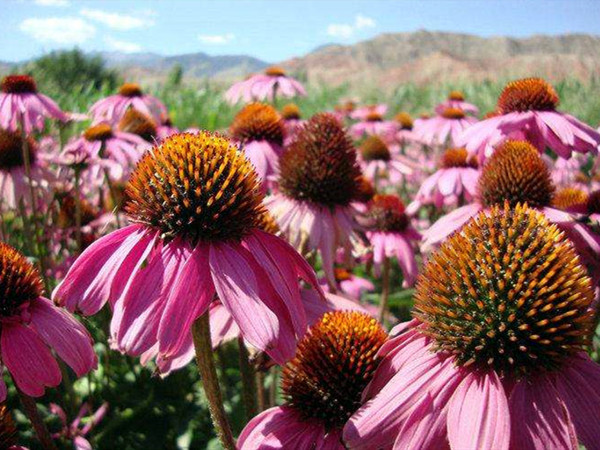Coneflower, also known as Echinacea, is a perennial herb from the compositae family, named for its head like a pine cone. Similar to common chrysanthemum, coneflower is ornamental with a variety of colors, beautiful and bright appearance, you can find them in the garden, park, street green space and is one of street greening and indispensable flower varieties. Whether you call it a wildflower or garden flower, the beauty of this herb is hard to ignore, and is an excellent plant for a home or a garden. Today here we will introduce the planting methods of purple coneflower, a variety widely grown because of its wide range of pharmacological effects.
Characteristics
Purple coneflowers are easy to grow from seed and do not require supplemental fertilizer. Once established, the plant will only need supplemental watering. The flowering period of purple coneflower is about June to September, with a long flowering period. The plant is about 1 meters high, the perennial roots overwinter, slightly cold. Prefers warm, sunny places and rich, organic-rich soil. All you need is a moist, well-drained soil that contains plenty of organic matter.
Planting from seeds
Planting the purple coneflower is a relatively simple process. You can start new plants from seeds or from a container. When you first start growing a plant from seed, be sure to wear gloves and put it on a paper plate or a screen. Once the seeds have completely dried, you can store them.The seed should be firm to the touch and darker than the flower itself. A careful approach to harvesting seeds is recommended for this flower, as the coneflower seeds are often covered in sharp spines. Soaking them is an excellent way to cultivate purple coneflower.
Soil
Purple coneflower is more tolerant of poor soil than one might expect and extremely drought-tolerant. But that doesn’t mean echinacea can grow healthily in the yard without any care. Echinacea likes well-drained soil and plenty of suns. The soil should be rich in humic acid soil, the light time should not be less than 4 hours, which is the premise of its long flowering. Once established, you can easily propagate the plant by starting seeds or transplanting it from a container.
Temperature and light
A good place to plant purple coneflower requires six to eight hours of full sunlight and should never be planted in partial shade or some light shade. In the growing period of Purple coneflower, the best day temperature is 16℃~24℃, and the best night temperature is 10℃~16℃. The flowering stage requires 7 to 8 weeks of intense light. It grows best in the fall because the plant is dormant during the hotter months. The flowers will last until frost. In northern areas, flowers usually bloom in late May and last until September.
Notes
Weeds should be removed as soon as the echinacea is growing. They compete with the echinacea for water and fertilizer, spreading disease. Do not harm beneficial insects when you come across them. Some insects prey on the pests that harm the echinacea. Bees can spread pollen and should be carefully protected when spraying insecticides. The main pests to the echinacea are the Japanese beetle and the weevil. At the same time, powdery mildew and gray mold may also occur in dense vegetation or rainy season. Preventive measures should be taken in advance and chemical methods should be used if necessary. The roots of echinacea should be protected from freezing in winter, However, the first year can be frosty, so consider using a protective covering to protect them. Once established, they will be hardy and reliable.
Planting purple coneflower at home is easy and has many of fun. It is its ability to attract pollinating insects. Bees and butterflies love their nectar-rich petals, which are an excellent source of food. Many people choose to take flower and root tea of purple coneflower daily during the winter to help you avoid colds and flu because it has been shown to reduce the duration of colds and flu. If you have rheumatoid arthritis and are troubled by steroid-based anti-inflammatory drugs, echinacea can be used as a mild analgesic to relieve symptoms with no side effects. So consider growing these beautiful and useful plants at home.
- Dandelion Extract: What It Is, Benefits, Uses and Side Effect - April 23, 2024
- Is Berberine Extract Help For Weight Loss? - April 11, 2024
- Why Is Pysllium Husk Powder A Popular Meal Replacement Ingredient? - April 3, 2024



